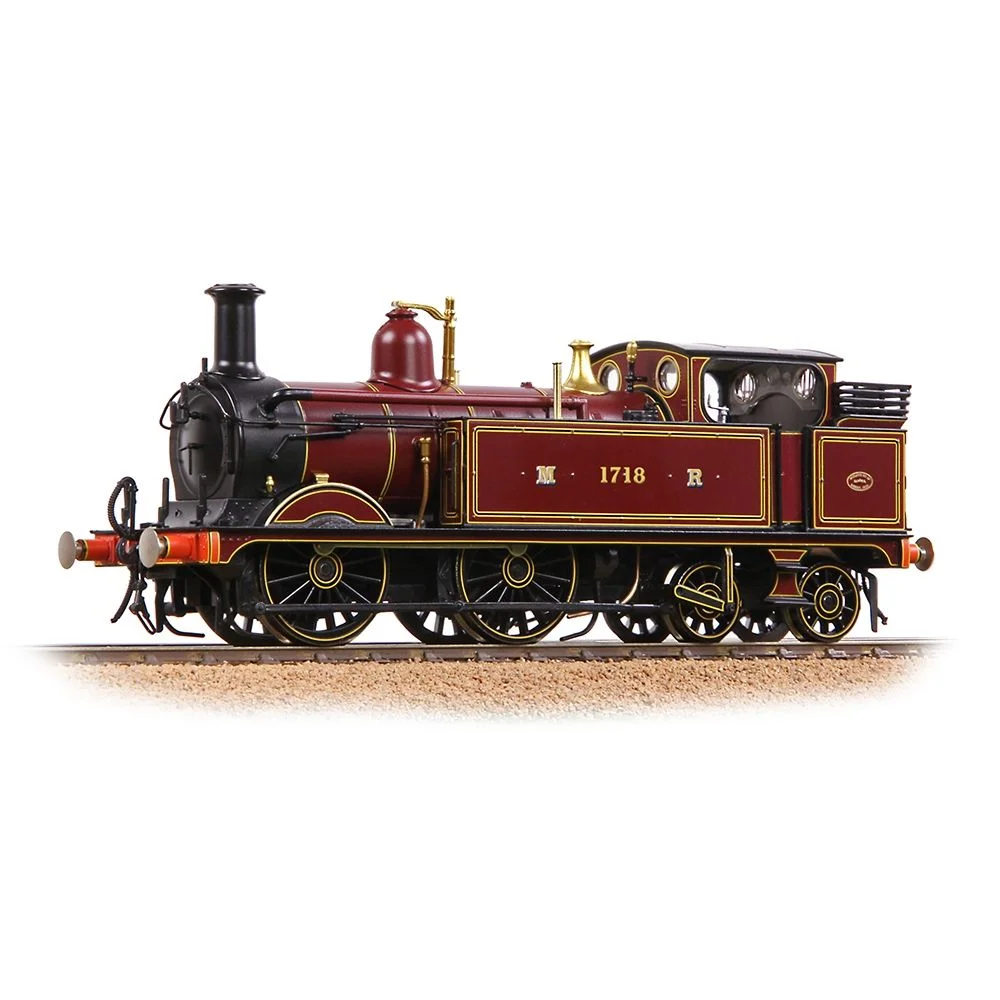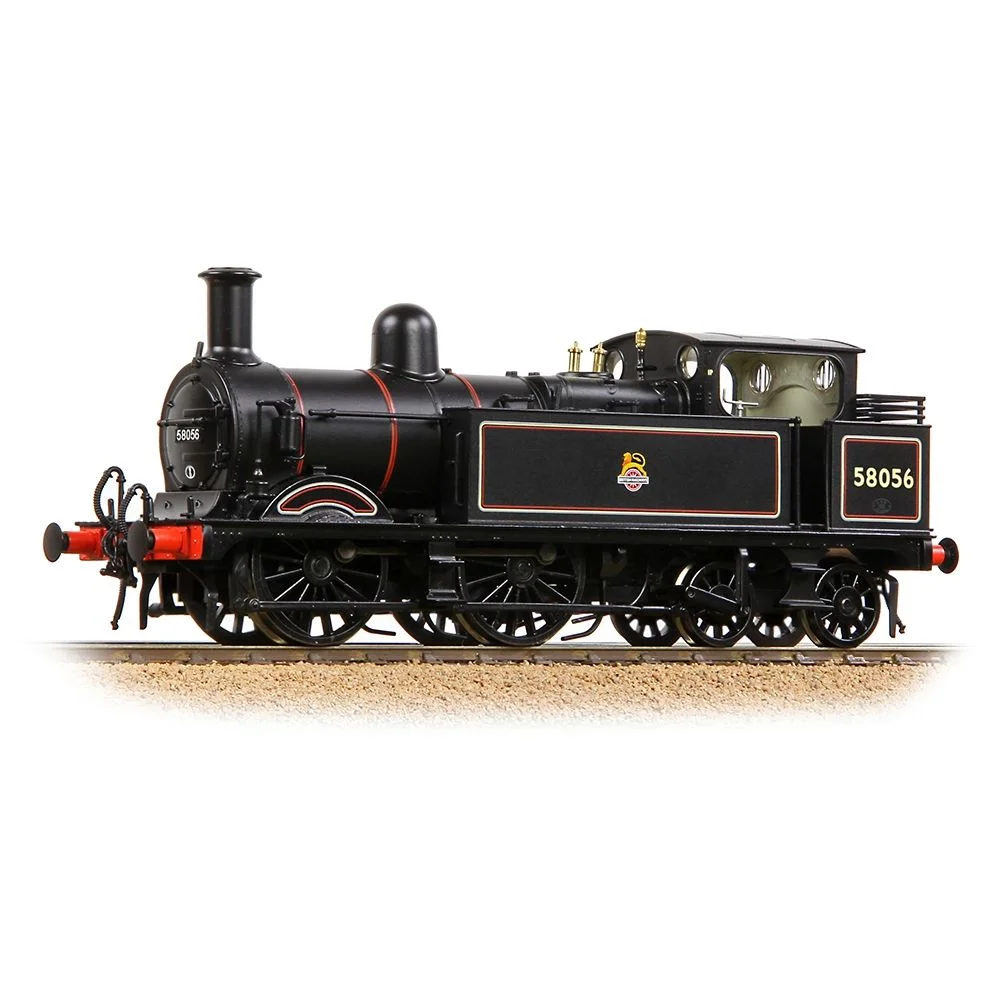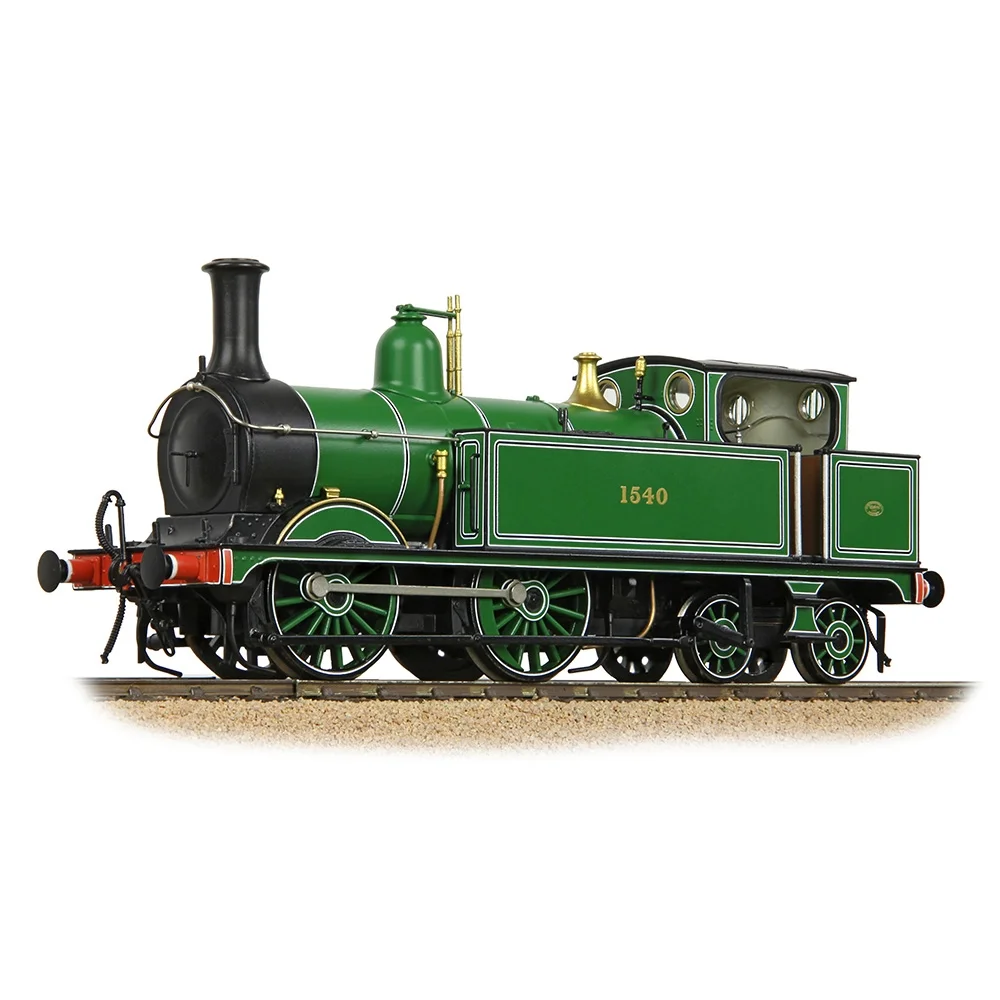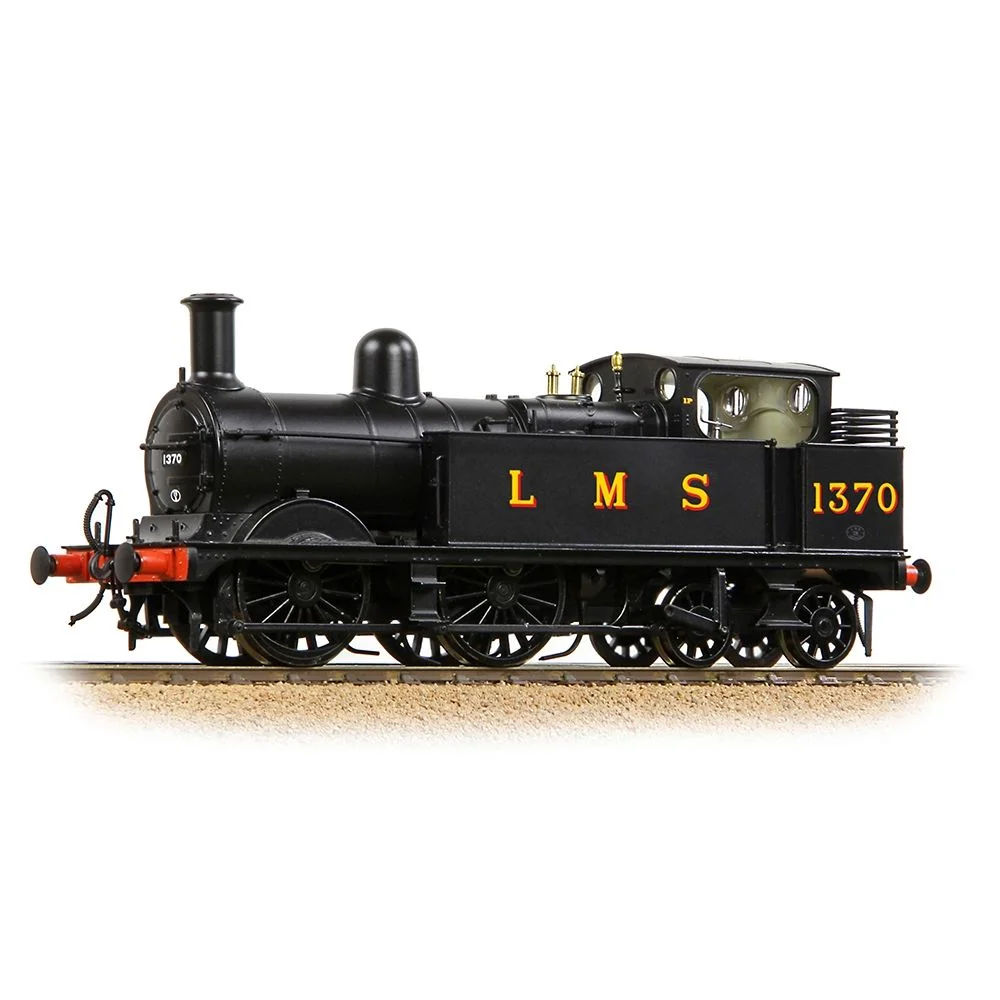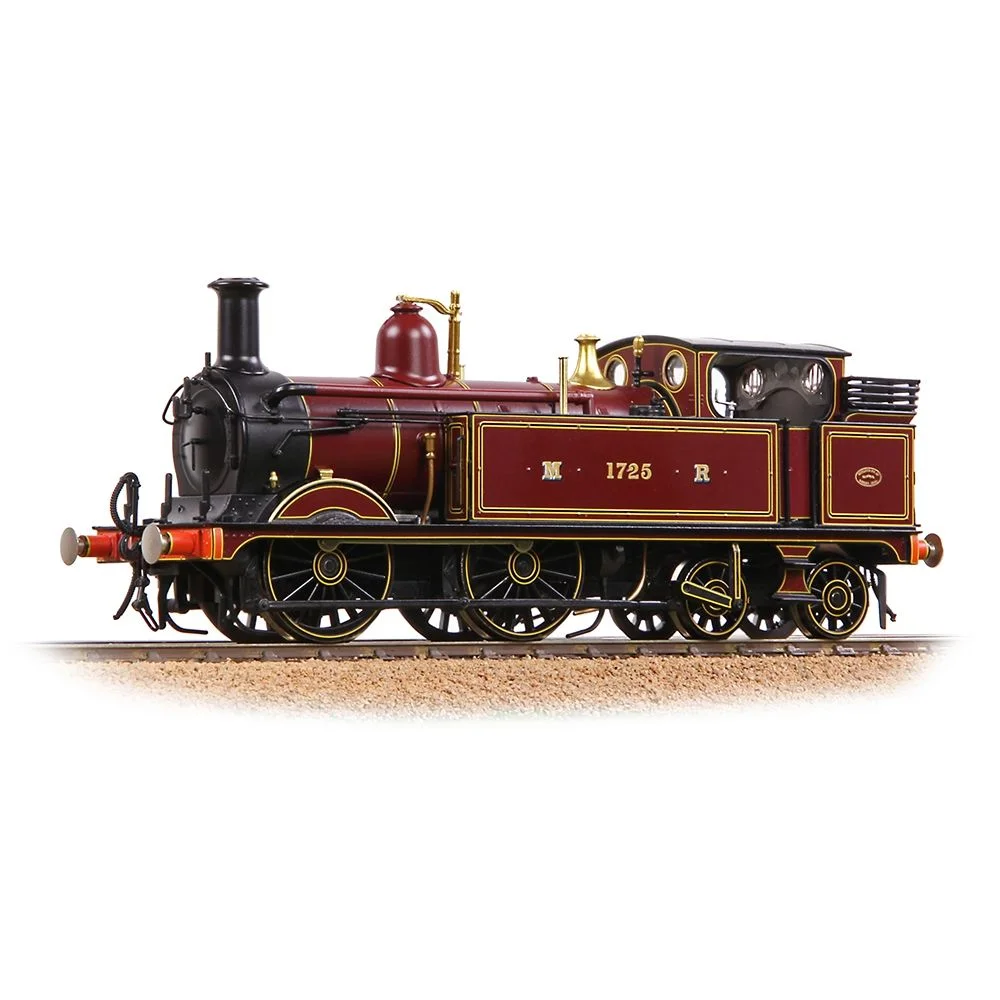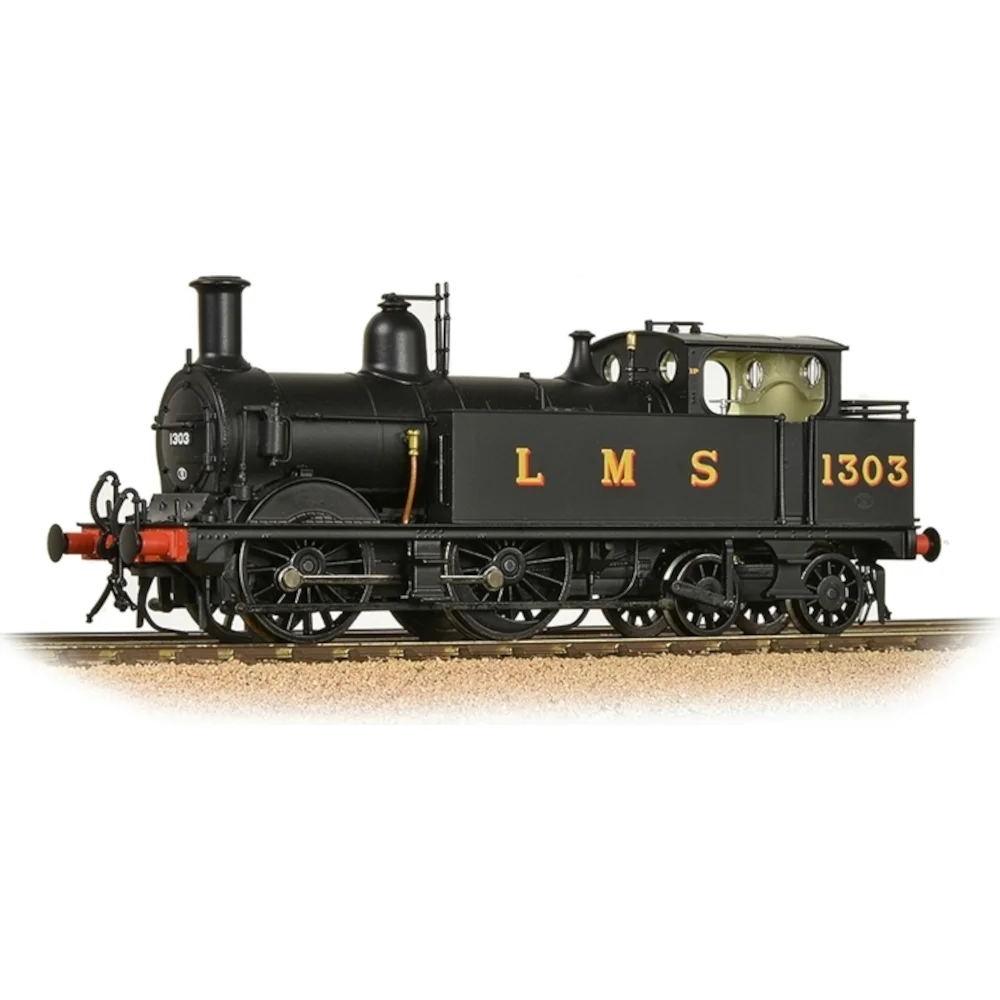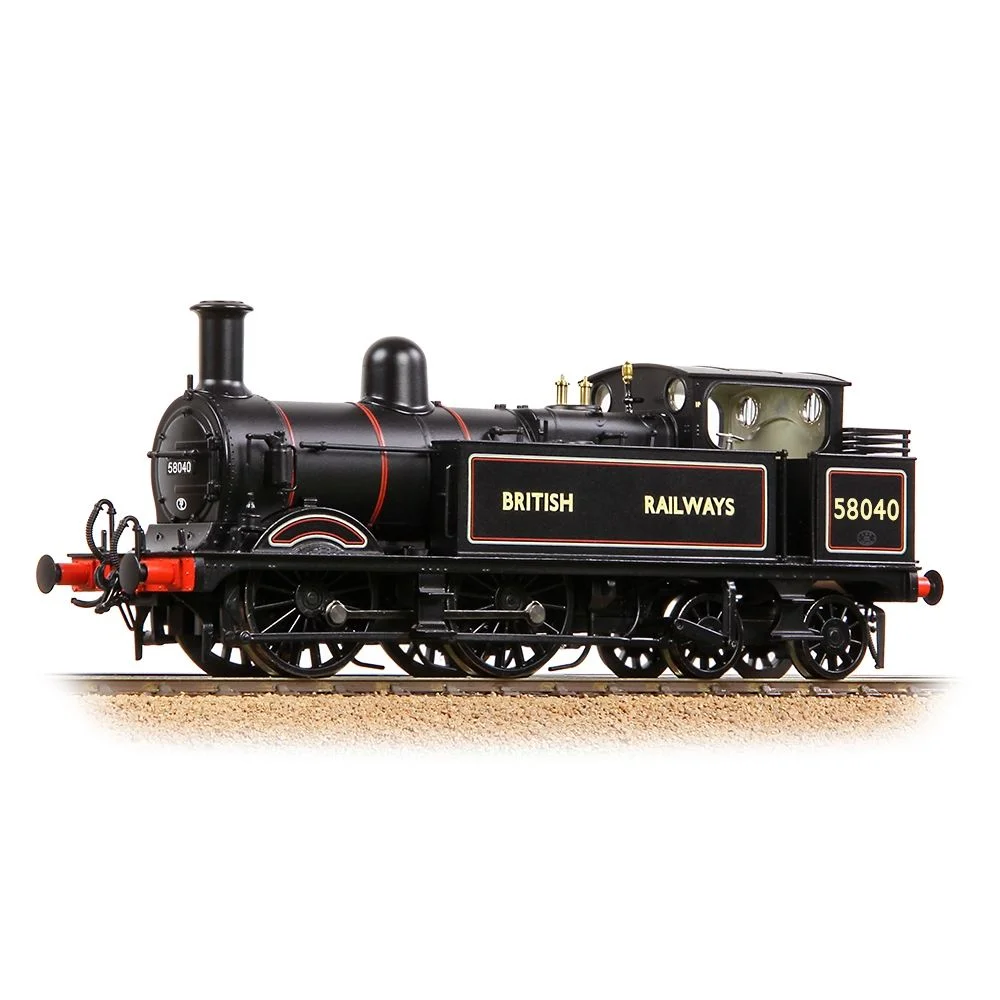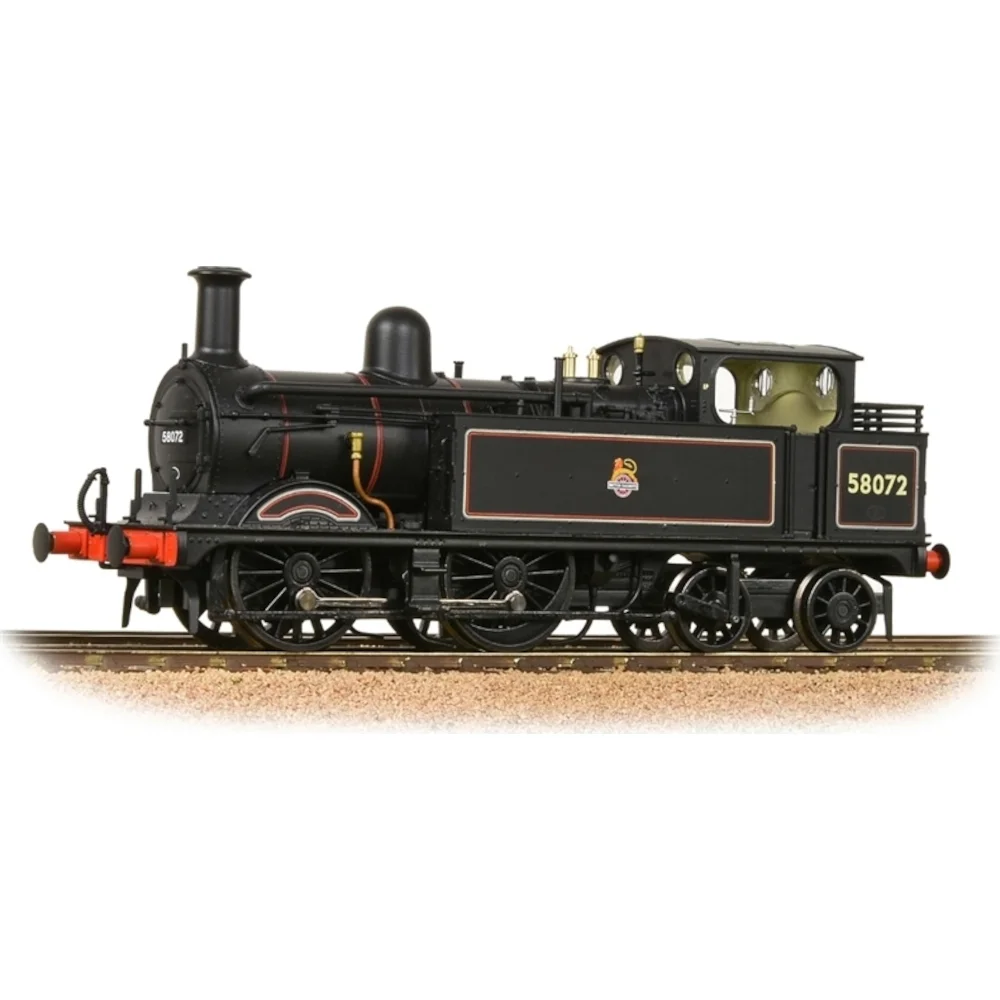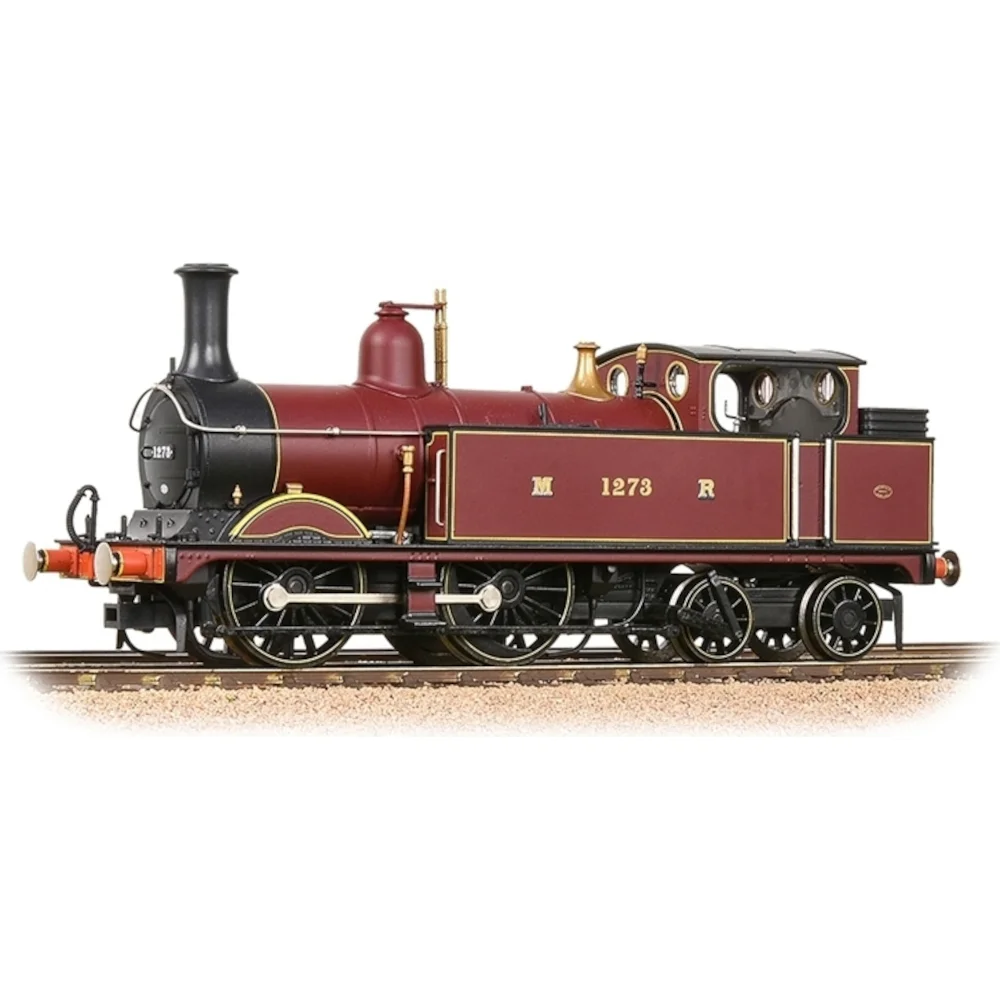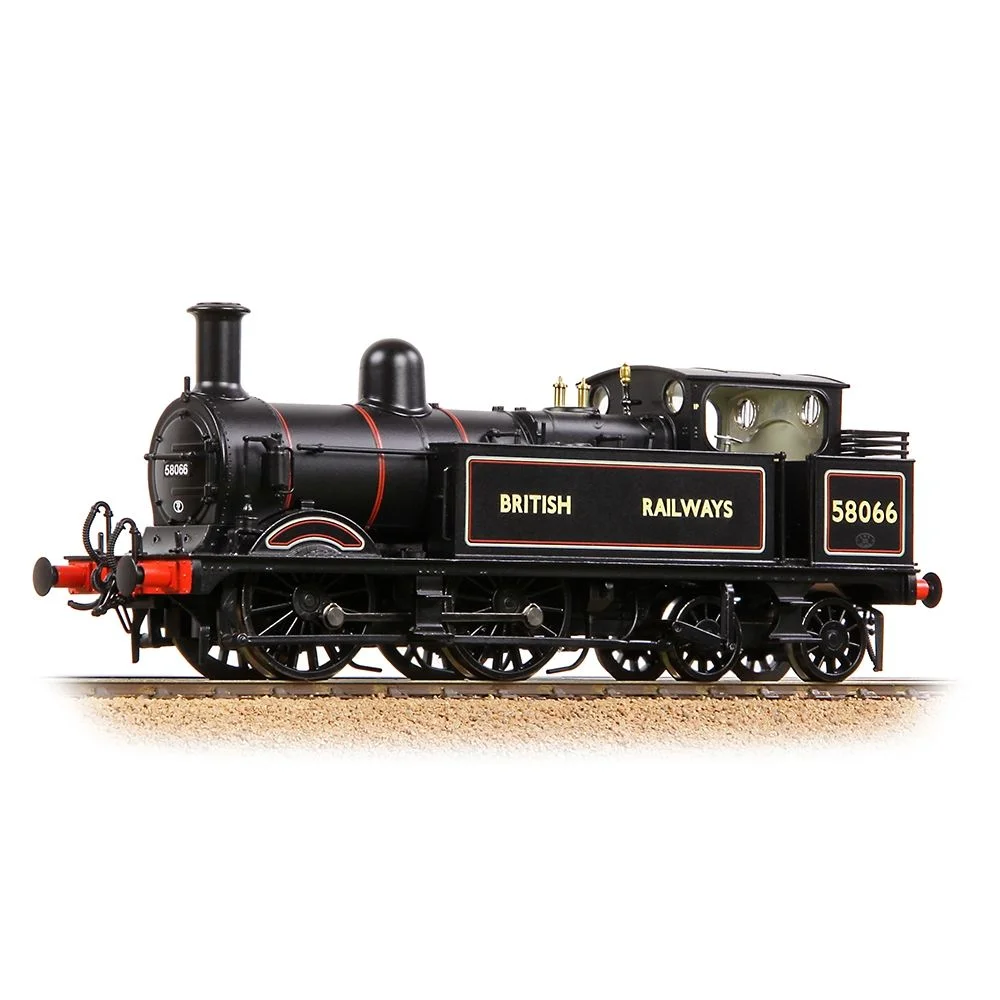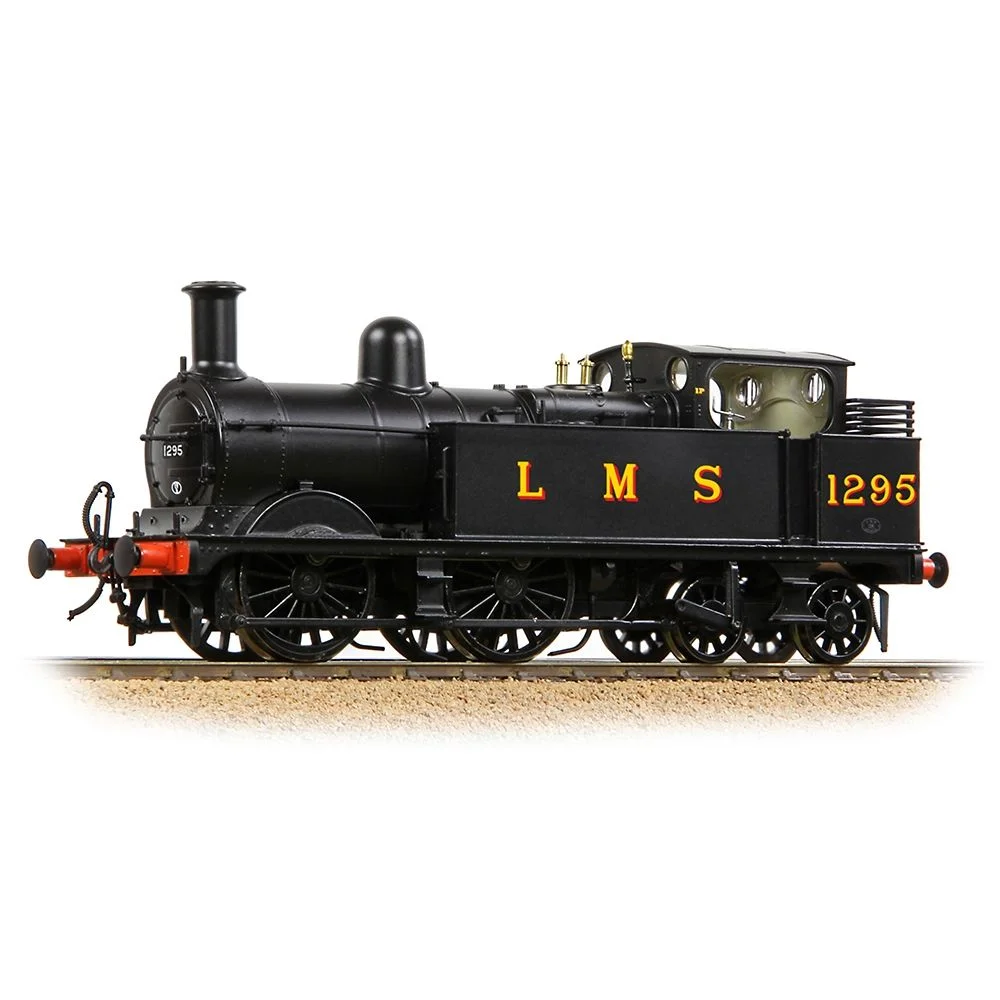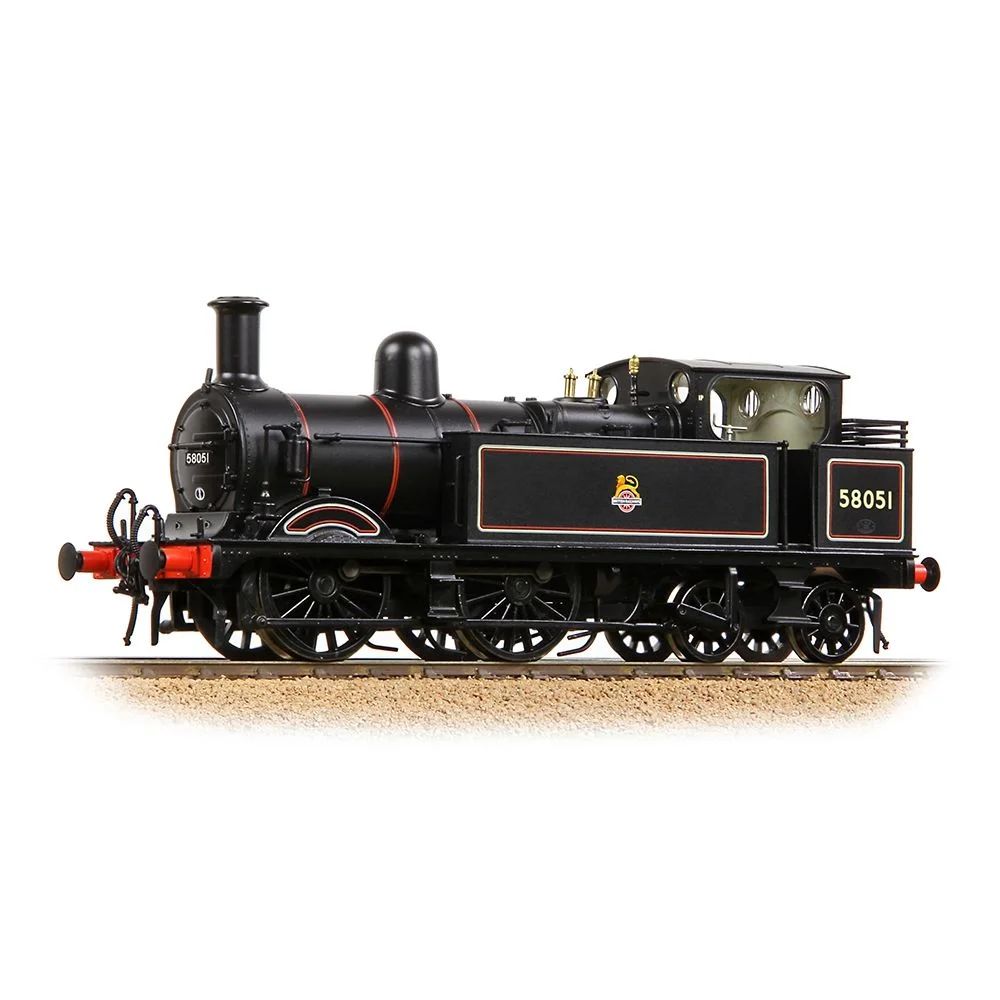Midland Railway 1532 Class – Johnson's Suburban Stalwarts 1881-1956
Contents
The Midland Railway 1532 Class represents one of the most enduring yet overlooked locomotive designs in British railway history. Samuel W. Johnson's elegant 0-4-4T suburban tanks, built at Derby Works between 1881 and 1886, served continuously for 75 years across three railway eras—from Victorian crimson lake splendour through LMS pragmatism to British Railways' final days of steam. Sixty-five locomotives formed the backbone of Midland suburban and branch operations from Yorkshire to Somerset, embodying the company's famous "small engine policy" whilst proving remarkably adaptable through progressive modifications including Belpaire boiler replacements and push-pull equipment.
For model railway enthusiasts, the MR 1532 Class offers compelling prototype appeal: historically significant, visually distinctive, and blessed with fascinating operational stories spanning metropolitan tunnel work to rural branch lines. Though none survived into preservation, Bachmann's exceptional OO gauge range since 2020 has finally given modellers access to this important class with unprecedented accuracy across multiple livery periods and technical variations.
From hauling 3-6 coach suburban formations around Manchester and Leeds to working the Somerset & Dorset's challenging gradients, the 1532 Class proved that Johnson's conservative design philosophy could deliver remarkable longevity. The final survivor operated until October 1956—an extraordinary 75-year service career that vindicated the Midland's commitment to standardised, well-maintained locomotives over increasingly powerful but more complex alternatives.
Quick Takeaways
- Sixty-five locomotives built: Constructed at Derby Works across five batches between 1881-1886, representing Johnson's refined 0-4-4T design
- Condensing apparatus innovation: Thirteen locomotives fitted with specialised equipment for Metropolitan Railway London underground tunnel operations
- 75-year service span: From 1881 debut until October 1956 final withdrawal, encompassing Midland Railway, LMS, and British Railways eras
- Progressive modifications: Systematic Belpaire boiler replacements, push-pull equipment additions, and multiple chimney/bunker pattern variations through service life
- Wide geographic distribution: Operated from London Metropolitan tunnels to Yorkshire suburbs, Manchester area, Bristol, Somerset & Dorset Joint Railway, and countless Midland branches
- Exceptional model availability: Bachmann's comprehensive OO gauge range includes 22+ variants across Midland crimson lake, LMS black, and BR lined black liveries
- Small engine policy exemplar: Classified 1P (light passenger), these locomotives validated Midland's philosophy of frequent services with standardised, economical motive power
Historical Background and Context
The genesis of the 1532 Class lay in Samuel W. Johnson's systematic development of Midland Railway suburban tank locomotive designs during the late Victorian period. Johnson had joined the Midland in 1873 from the Great Eastern Railway's Stratford Works, specifically recruited to provide modern motive power for the company's expanding London suburban traffic and growing network of branch lines requiring frequent passenger services.
The 1532 Class represented the third iteration in a carefully planned design evolution. Johnson's pioneer 6 Class of 1875 introduced the fundamental 0-4-4T wheel arrangement with side tanks, replacing earlier well tank designs that had proven problematic for maintenance access. Ten locomotives with 5ft 3in driving wheels established the basic mechanical layout that would characterise Midland suburban tanks for the next six decades.
The subsequent 1252 Class of 1875-1876 expanded the concept to thirty locomotives built by Neilson & Company, featuring slightly larger 5ft 6½in driving wheels that provided improved speed capability for longer suburban runs. These locomotives proved highly successful, validating Johnson's design philosophy and establishing confidence for larger-scale production of a refined variant.
The MR 1532 Class emerged as the optimised expression of this development programme. Johnson's decision to specify 5ft 3½in driving wheels—marginally smaller than the 1252 Class—reflected careful analysis of suburban operational requirements. The reduced wheel diameter traded a modest amount of top speed for significantly improved acceleration and tractive effort, crucial advantages for stop-start suburban work with frequent station calls.
Insider Tip: Condensing Apparatus Recognition
Thirteen 1532 Class locomotives carried condensing equipment for Metropolitan Railway tunnel work. You can identify these specialised examples by their enlarged side tanks with distinctive ventilation gaps and prominent condensing pipes running along the boiler sides. The apparatus captured exhaust steam, cooling it in the enlarged tanks before release, dramatically reducing tunnel atmosphere pollution. Modellers should note this feature when recreating authentic Kentish Town depot allocations.
Derby Works commenced construction under Order No. 289 in 1881, with the first locomotive, No. 1532, entering service that same year. The initial batch of twenty locomotives (Nos. 1532-1551) included the pioneering condensing-equipped examples (Nos. 1547-1551), demonstrating Johnson's innovative response to the specific challenges of underground railway operation.
Contemporary railway periodicals praised the new design's elegant proportions and robust construction. The distinctive Johnson styling—featuring shaped 3ft 1in chimneys, dished smokebox doors with over-mounted handrails, round-top fireboxes with Salter-valved domes, low cab front windows, and gracefully flared bunkers—created an immediately recognisable profile that epitomised Midland Railway aesthetic standards during the company's Derby red livery period.
Design and Technical Specifications
The engineering excellence of the Midland Railway 1532 Class lay in Samuel Johnson's masterful balance between performance requirements and the Midland's rigorous standardisation philosophy. At the heart of the design was the proven Type C boiler, pressed to 150-160 lbf/in² and featuring a heating surface of 1,000 square feet combined with 120 square feet of superheating surface in later examples.
The locomotive configuration followed established Midland practice with inside cylinders measuring 17in diameter by 24in stroke in original specification, universally enlarged to 18in diameter during early service life to address reports of insufficient power on heavier suburban formations. This modification increased tractive effort from approximately 14,500 lbf to the final specification of 15,490 lbf, providing noticeably improved acceleration without compromising the design's fundamental characteristics.
The wheel arrangement utilised 5ft 3½in diameter coupled driving wheels paired with 3ft 0½in diameter trailing wheels, creating an asymmetrical but well-balanced wheelbase totalling 22ft 9in. The spacing—8ft 0in between leading and driving axles, 9ft 9in between driving axles, and 5ft 0in from rear driving axle to trailing axle—provided excellent riding characteristics whilst maintaining the compact dimensions essential for operation through restrictive clearances on older Midland branches.
Weight distribution was carefully calculated to maximise adhesion whilst remaining within axle loading restrictions that characterised much Midland infrastructure. The locomotive weighed 50 long tons 9 cwt in working order, with the side tanks carrying 1,200 gallons of water and the coal bunker accommodating approximately 1.5 tons of fuel. This modest capacity reflected the class's intended role on suburban services with frequent coaling and watering opportunities rather than long-distance main line work.
Technical Innovation: The Belpaire Transformation
The London Midland & Scottish Railway's systematic Belpaire boiler replacement programme fundamentally transformed many 1532 Class locomotives during the 1920s-1940s. The angular Belpaire firebox provided increased heating surface and improved steam generation compared to the original round-top design, whilst necessitating cascading modifications including relocated cab windows, altered bunker profiles, and different chimney patterns. This created two distinct visual variants that modellers can authentically represent across different periods.
The frame construction employed substantial inside plate frames of typical Derby Works quality, ensuring rigidity sufficient for decades of intensive suburban operation. Stephenson valve gear actuated slide valves in the original specification, though some locomotives received piston valve conversions during major overhauls. The simplicity and accessibility of this mechanical arrangement facilitated the rapid maintenance turnaround essential for locomotives in intensive suburban service.
The condensing apparatus fitted to thirteen locomotives represented sophisticated engineering for its era. The enlarged side tanks incorporated ventilation gaps and internal baffles to cool captured exhaust steam, whilst the condensing pipes—prominently visible along the boiler sides—directed steam from the cylinders into the cooling tanks. This equipment added approximately one ton to locomotive weight but proved essential for Metropolitan Railway operations where unvented exhaust would have created intolerable tunnel atmosphere conditions.
Service History and Operations
The MR 1532 Class quickly established itself across the Midland Railway's extensive suburban and branch network, with deployment patterns revealing both the versatility of Johnson's design and the geographic diversity of Midland operations. Initial allocations from the first batch saw eleven locomotives stationed at Manchester (London Road and Central), supporting the intensive suburban services radiating from the city to Stockport, Macclesfield, and numerous intermediate stations.
The five condensing-equipped locomotives from this batch (Nos. 1547-1551) concentrated at Kentish Town depot in North London, specifically for Metropolitan Railway operations through the capital's underground tunnels. These specialised duties demanded the sophisticated exhaust steam capture system, preventing the severe atmospheric pollution that characterised early underground railway operations with conventional steam locomotives venting directly into confined tunnel spaces.
Yorkshire allocations included Manningham (Bradford) and surrounding depots, where 1532 Class locomotives handled intensive suburban traffic across the West Riding's densely populated industrial towns. Services connected Bradford with Leeds, Halifax, Keighley, and countless smaller communities, with typical diagrams involving 15-20 return trips daily over relatively short distances—precisely the intensive stop-start work for which the 5ft 3½in driving wheels provided optimal acceleration characteristics.
The remaining first-batch locomotives dispersed widely: Walsall (West Midlands local services), Bristol (Bath Road depot for Somerset services), Thornbury (branch line work), Reddish (Manchester area), Malvern (Worcestershire branches), and Bourne in Lincolnshire (rural branch operations). This geographic spread—from metropolitan London to rural Lincolnshire—demonstrated the class's fundamental suitability for the diverse passenger work encompassed by the Midland's 1P power classification.
Operational Insight: The Somerset & Dorset Connection
One 1532 Class locomotive achieved special distinction through transfer to the Somerset & Dorset Joint Railway. No. 1305 moved permanently to the S&DJR in January 1921, becoming S&DJR No. 54 and wearing the distinctive Prussian blue livery with vermillion lining. The locomotive returned to LMS stock in 1930 following the S&DJR's absorption, providing a unique livery variation that Bachmann has commemorated with a special Collectors Club edition model.
Subsequent construction batches between 1883-1886 added forty-five more locomotives (Nos. 1632-1737), with the final two batches including eight additional condensing-equipped examples (Nos. 1718-1725). These locomotives saw similarly diverse deployment, though concentrations emerged at key suburban centres including Derby (naturally, given Derby Works' maintenance role), Nottingham, Leicester, and numerous smaller depots across the former Midland network.
The London Midland & Scottish Railway inherited 62 locomotives at the 1923 Grouping (two had already been withdrawn, one had transferred to the S&DJR). The LMS retained the 1907 Midland renumbering scheme (1266-1330) throughout the company's existence, with the locomotives classified 1P under the LMS power classification system that replaced Midland's descriptive approach.
LMS ownership brought systematic technical improvements, particularly the Belpaire boiler replacement programme that fundamentally transformed many locomotives' appearance and performance. The angular Belpaire firebox provided enhanced steam generation compared to round-top originals, whilst the modifications necessitated complementary changes including relocated cab windows (moved higher to clear the taller firebox), altered bunker profiles (straight sides replacing flared originals), and different chimney patterns (Deeley 3ft standard replacements for Johnson shaped originals, with some later receiving Stanier patterns).
Push-pull equipment became increasingly common from the 1930s onwards as branch line economics demanded crew-saving operating methods. Visible modifications included pumps fitted to smokebox sides with linkages to cab roof, additional vacuum pipes on bufferbeams for remote control, and whistle control apparatus enabling drivers to operate from the trailing coach. These conversions extended the class's utility on lightly-trafficked branches where full locomotive-hauled formations would have been uneconomical.
Withdrawals commenced in August 1919 with No. 1281, proceeding gradually through the interwar years as newer designs became available and older Midland infrastructure was upgraded or abandoned. Accelerated scrapping occurred during 1930-1931 when thirteen locomotives were condemned, reflecting the LMS's systematic fleet rationalisation as Derby Works production of modern standardised types gathered momentum.
British Railways inherited just fourteen survivors at nationalisation on 1st January 1948. The locomotives received allocated numbers 58039-58051 in March 1948, though five were withdrawn before carrying their new identities. The final examples operated in increasingly archaic condition, with contemporary accounts describing them as "very handsome" despite obvious age but clearly approaching obsolescence in the modern railway environment.
The ultimate survivor, No. 58051 (originally MR 1330), was withdrawn in October 1956 from Bath Green Park depot on the former Somerset & Dorset Joint Railway. This marked the end of 75 continuous years of 1532 Class service—an extraordinary longevity that vindicated Samuel Johnson's design philosophy and the Midland Railway's commitment to well-maintained, standardised motive power over increasingly powerful but more complex alternatives.
Fleet
No locomotives found.
Withdrawal and Preservation Legacy
The withdrawal history of the Midland Railway 1532 Class reflects both the gradual obsolescence of Victorian-era tank locomotives and the surprising longevity achieved through systematic maintenance and progressive modification. Unlike many contemporary designs that faced rapid scrapping following the 1923 Grouping, the 1532 Class continued earning its keep for decades under LMS and British Railways ownership.
Early withdrawals began in August 1919 with No. 1281, followed by sporadic condemnations through the 1920s as traffic patterns evolved and newer locomotives became available. The pattern accelerated significantly during 1930-1931 when thirteen locomotives faced the cutter's torch, reflecting the London Midland & Scottish Railway's systematic fleet rationalisation as modern standardised designs from Derby, Crewe, and Horwich Works entered service.
The condensing-equipped locomotives faced particularly early withdrawal as Metropolitan Railway electrification progressively reduced steam operations through London's underground tunnels. The sophisticated condensing apparatus—once essential technology—became redundant weight and maintenance burden once electric traction eliminated the atmospheric pollution problem that had necessitated exhaust steam capture.
By the outbreak of World War Two in September 1939, approximately thirty locomotives remained in service, concentrated increasingly on rural branch lines and secondary suburban duties where their modest power output and economical operation remained competitive against newer but more expensive alternatives. Wartime traffic intensity provided temporary reprieve, with surviving examples working intensively to support the war effort.
Post-war rationalisation resumed with determination. British Railways' 1948 nationalisation found just fourteen survivors scattered across former Midland territory, with concentrations on the Somerset & Dorset Joint Railway where the challenging gradients and tight clearances suited their compact dimensions and adhesive qualities. The locomotives received allocated numbers 58039-58051 in March 1948, though five never carried these identities before withdrawal.
Preservation's Lost Opportunity
Tragically, not one of the 65 locomotives survived into preservation. The final withdrawals in 1956 preceded the preservation movement's expansion in the late 1950s-1960s, whilst the locomotives' modest size and suburban role lacked the glamour that attracted early preservationists focused on express passenger types. This makes Bachmann's comprehensive model range particularly valuable—these are the only way modern enthusiasts can appreciate Johnson's elegant design in any form.
The final years saw increasingly decrepit condition as British Railways prioritised maintenance resources on newer types. Period photographs from Bath Green Park and other Somerset & Dorset locations show locomotives with patched boilers, mismatched components, and general neglect—yet still gamely hauling branch trains through the Somerset countryside. The sight of 1880s-vintage tanks in 1950s service illustrated both the fundamental soundness of Johnson's engineering and the changing economics that made their retention increasingly untenable.
No. 58051's October 1956 withdrawal at Bath Green Park marked the end. The locomotive was towed to Derby Works and scrapped shortly thereafter, joining its 64 classmates in oblivion. No museum preservation, no static display, no heritage railway rescue—the entire class vanished without a single representative surviving to demonstrate Johnson's elegant suburban tank design to future generations.
The engineering legacy proved more enduring than any physical survivor. The 1532 Class validated design principles that influenced British tank locomotive development for decades: modest power ratings matched to specific duties, standardised components enabling economical maintenance, conservative loadings extending service life, and progressive modification capability allowing adaptation to changing operational requirements. These lessons informed subsequent Midland, LMS, and British Railways tank locomotive designs through the diesel era.
Modelling Significance and Scale Replications
The MR 1532 Class presents exceptional modelling significance due to its unique position spanning Victorian, Edwardian, LMS, and early British Railways eras, combined with the distinctive visual evolution from crimson lake elegance through multiple technical and livery transformations. For railway modellers seeking authentic period atmosphere, these locomotives provide compelling prototype appeal enhanced by fascinating operational stories and geographic diversity.
The modelling landscape remained frustratingly barren for decades despite the class's historical importance. No manufacturer—neither Hornby, Dapol, Heljan, Graham Farish, nor specialist kit producers—offered 1532 Class representations in any scale. This inexplicable neglect left modellers of Midland, LMS, and early BR suburban operations without a fundamental locomotive type that should have been considered essential for authentic layout operation.
This changed dramatically when Bachmann Branchline announced the 1532 Class in January 2017 as part of their expanding Midland/LMS locomotive range. The first models reached enthusiasts in 2020, immediately earning acclaim for exceptional detail quality, comprehensive prototype accuracy, and thoughtful attention to the numerous variations that characterised the class throughout its 75-year service career.
Bachmann's approach demonstrates exemplary commitment to prototype authenticity. Rather than producing a single generic model with alternative running numbers, the company created extensive tooling variations representing the class across its entire evolution. The range encompasses over 22 distinct catalogue numbers organised into coherent series: Midland Railway crimson lake (31-740 series), LMS black (31-741 series), BR lined black with early emblem (31-742 series), BR lined black with "British Railways" lettering (31-743 series), plus special editions including a Somerset & Dorset Prussian blue version.
Each series includes both DCC Ready versions (featuring Next18 decoder socket) and DCC Sound Fitted variants with pre-installed ESU Loksound Micro V5 decoders offering 20+ functions including playable whistle, cylinder drain cocks, shovelling coal, water tank filling, injectors, guard's whistle, and numerous other prototypical effects. The sound-fitted models operate on both DCC and conventional DC control with basic sound functions available on analogue layouts—a valuable feature for modellers transitioning between control systems.
Models
| Builder | Catalogue # | Year | Running # | Class, Operator (Livery) "Name" | Scale | Finish | Era | DCC |
|---|---|---|---|---|---|---|---|---|
| Bachmann | 31-740 | 2017 | 1273 | Midland Railway 1532 Class, Midland Railway (Crimson Lake) | OO | P | 2 | N18DCC |
| Bachmann | 31-740A | 2024 | 1725 | Midland Railway 1532 Class, Midland Railway (Crimson Lake) | OO | P | 2 | N18DCC |
| Bachmann | 31-740ASF | 2024 | 1725 | Midland Railway 1532 Class, Midland Railway (Crimson Lake) | OO | P | 2 | DCCS |
| Bachmann | 31-740B | 2024 | 1718 | Midland Railway 1532 Class, Midland Railway (Crimson Lake) | OO | P | 2 | N18DCC |
| Bachmann | 31-740BSF | 2024 | 1718 | Midland Railway 1532 Class, Midland Railway (Crimson Lake) | OO | P | 2 | DCCS |
| Bachmann | 31-740SF | 2022 | 1273 | Midland Railway 1532 Class, Midland Railway (Crimson Lake) | OO | P | 2 | DCCS |
| Bachmann | 31-741 | 2017 | 1303 | Midland Railway 1532 Class, London, Midland & Scottish Railway (Black) | OO | P | 3 | N18DCC |
| Bachmann | 31-741A | 2024 | 1370 | Midland Railway 1532 Class, London, Midland & Scottish Railway (Black) | OO | P | 3 | N18DCC |
| Bachmann | 31-741ASF | 2024 | 1370 | Midland Railway 1532 Class, London, Midland & Scottish Railway (Black) | OO | P | 3 | DCCS |
| Bachmann | 31-741B | 2024 | 1295 | Midland Railway 1532 Class, London, Midland & Scottish Railway (Black) | OO | P | 3 | N18DCC |
| Bachmann | 31-741BSF | 2024 | 1295 | Midland Railway 1532 Class, London, Midland & Scottish Railway (Black) | OO | P | 3 | DCCS |
| Bachmann | 31-741SF | 2022 | 1303 | Midland Railway 1532 Class, London, Midland & Scottish Railway (Black) | OO | P | 3 | DCCS |
| Bachmann | 31-742 | 2017 | 58072 | Midland Railway 1532 Class, British Railways (Lined Black with Early Emblem) | OO | P | 4 | N18DCC |
| Bachmann | 31-742A | 2024 | 58051 | Midland Railway 1532 Class, British Railways (Lined Black with Early Emblem) | OO | P | 4 | N18DCC |
| Bachmann | 31-742ASF | 2024 | 58051 | Midland Railway 1532 Class, British Railways (Lined Black with Early Emblem) | OO | P | 4 | DCCS |
| Bachmann | 31-742B | 2024 | 58056 | Midland Railway 1532 Class, British Railways (Lined Black with Early Emblem) | OO | P | 4 | N18DCC |
| Bachmann | 31-742BSF | 2024 | 58056 | Midland Railway 1532 Class, British Railways (Lined Black with Early Emblem) | OO | P | 4 | DCCS |
| Bachmann | 31-742SF | 2022 | 58072 | Midland Railway 1532 Class, British Railways (Lined Black with Early Emblem) | OO | P | 4 | DCCS |
| Bachmann | 31-743 | 2024 | 58066 | Midland Railway 1532 Class, British Railways (Lined Black) | OO | P | 4 | N18DCC |
| Bachmann | 31-743A | 2024 | 58040 | Midland Railway 1532 Class, British Railways (Lined Black) | OO | P | 4 | N18DCC |
| Bachmann | 31-743ASF | 2024 | 58040 | Midland Railway 1532 Class, British Railways (Lined Black) | OO | P | 4 | DCCS |
| Bachmann | 31-743SF | 2024 | 58066 | Midland Railway 1532 Class, British Railways (Lined Black) | OO | P | 4 | DCCS |
| Bachmann | 31-744K* | 2025 | 1540 | Midland Railway 1532 Class, Midland Railway (Lined Green) | OO | P | 2 | N18DCC |
| Bachmann | 31-744KSF* | 2025 | 1540 | Midland Railway 1532 Class, Midland Railway (Lined Green) | OO | P | 2 | DCCS |
Advanced Modelling: Identifying Authentic Variants
Bachmann's tooling variations allow period-specific accuracy. Crimson lake Midland examples (Nos. 1273, 1718, 1725) feature round-top boilers, Johnson shaped chimneys, low cab windows, and flared bunkers. LMS black versions (Nos. 1295, 1303, 1370) represent Belpaire-fitted rebuilds with straight bunkers and Deeley chimneys. BR examples (Nos. 58040-58072) show late-service appearance with Belpaire boilers, BR smokebox numberplates, and push-pull equipment where appropriate. Matching locomotive to period is crucial for authentic representation.
The technical execution impresses throughout. A coreless motor drives all wheels with comprehensive electrical pickup from both locomotive and tender wheels, ensuring smooth operation at realistic crawling speeds appropriate for suburban station work. The diecast metal chassis and running plate provide satisfying weight (approximately 193g) and stability, whilst the minimum curve radius of second radius (438mm/17.25") suits most OO gauge layouts.
The only performance limitation noted in contemporary reviews concerns gradient capability—the compact wheelbase and relatively light weight can cause wheelslip when hauling six-coach formations on steep inclines. Bachmann addresses this by including optional traction tyre wheelsets with each model, easily fitted by modellers requiring enhanced adhesion for challenging gradient operation.
Detail quality reaches impressive standards for ready-to-run models. Separately applied handrails, lamp irons, vacuum pipes, and brake gear provide visual depth, whilst the factory-fitted glazing includes cab interior detail visible through windows. The accessory pack includes alternative parts for different configurations: cab doors (open/closed options), additional steps, extra pipework for push-pull equipment, and period-appropriate screw-link couplings.
Livery application demonstrates meticulous research and execution. The Midland Railway crimson lake features correct lining patterns with gold numerals and Derby coat of arms transfers, whilst LMS black versions show proper shaded transfers and appropriate numbering styles. British Railways examples correctly represent both early and late numbering/emblem variations, with lined black finish applied to appropriate standards for 1P power classification locomotives.
Pricing reflects the quality and comprehensive feature set: DCC Ready versions typically retail around £127-150, whilst Sound Fitted variants command £200-220 depending on retailer and specific catalogue number. Availability remains strong through all major UK model railway retailers including Rails of Sheffield, Hattons Model Railways, Kernow Model Rail Centre, The Model Centre, and numerous independent stockists.
The range's commercial success—Bachmann described it as producing "instant success" at release—has ensured continued production with new versions announced as recently as March 2025. This sustained commitment provides confidence for modellers planning layout locomotive rosters around accurate Midland/LMS/BR suburban prototypes.
Unique Modelling Tips and Layout Integration
Successfully incorporating Midland Railway 1532 Class models into layout operation requires understanding the specialised nature of their prototype duties and the authentic operating scenarios that characterised suburban and branch passenger work during the 1881-1956 period. Unlike main line express locomotives that might work prestigious named trains between major cities, the 1532 Class was typically assigned to humble but essential local services connecting smaller communities with the main network.
Authentic operating scenarios should reflect the intensive stop-start suburban role. A typical 1532 Class duty might involve 15-20 return trips daily over a 10-15 mile route with 8-12 intermediate stations, hauling formations of 3-6 non-corridor coaches carrying commuters, shoppers, and local travellers. This service pattern provides excellent operational interest whilst remaining true to prototype practice—each journey involves careful station stops, guard's whistle signals, and precise timekeeping essential for intensive suburban timetables.
Layout design should accommodate the class's operational characteristics and typical infrastructure. Suburban stations with modest platforms (4-6 coach lengths), passing loops enabling intensive service frequency, water columns for frequent replenishment, and small engine sheds with basic facilities all contribute to authentic atmosphere. The infrastructure should suggest secondary importance—no grand overall roofs or extensive passenger amenities, but functional facilities serving working-class communities.
Weathering Authenticity for Suburban Service
1532 Class weathering should reflect intensive suburban operation whilst maintaining the relatively clean appearance expected of passenger-rated locomotives. Focus on coal dust around bunker tops, light oil staining around motion components and side tank bottoms, and graduated exhaust effects on smokebox fronts. Avoid heavy industrial weathering inappropriate for passenger service—these locomotives operated from depots with regular cleaning facilities and received attention between intensive daily diagrams.
Era selection proves crucial for authentic 1532 Class representation. Midland Railway period layouts (1881-1922) demand crimson lake livery with round-top boilers, Johnson fittings, and period-appropriate coaching stock—the company's distinctive clerestory roof designs create visually striking formations. LMS layouts (1923-1947) can represent transitional appearance with some locomotives retaining crimson lake into the mid-1920s, progressive adoption of LMS black, and the Belpaire boiler replacement programme creating mixed fleets. British Railways layouts (1948-1956) should show late-service appearance with lined black livery, BR emblems, and increasingly decrepit condition appropriate for Victorian-era locomotives nearing withdrawal.
Coaching stock selection requires careful attention to period authenticity. 1532 Class locomotives typically hauled non-corridor compartment stock rather than main line corridor formations. Midland Railway period operation demands the company's distinctive clerestory roof compartment coaches in crimson lake with white upper panels. LMS period suggests standard Period III non-corridor stock in crimson lake or later maroon. British Railways operation from 1948-1956 requires early BR crimson & cream or later maroon non-corridor compartment stock appropriate for suburban service.
Train lengths should reflect the class's modest 15,490 lbf tractive effort and 1P power classification. Typical formations involved 3-4 coaches on branch lines, 4-6 coaches on suburban services, with 6-coach formations representing maximum loading on level routes. Attempting to haul main line corridor formations would be prototypically inaccurate—these locomotives were specifically designed for lighter suburban work rather than heavy long-distance trains.
Sound-equipped models benefit from careful attention to the 1532 Class's distinctive operational characteristics. The modest power output and intensive stop-start duty created particular exhaust patterns—gentle drifting at station platforms, sharp barks during acceleration, and steady rhythmic beats during running between stops. Programming sound decoders to emphasise these characteristics through appropriate volume levels and timing creates authentic atmosphere.
Push-pull operation provides fascinating operational possibilities for branch line scenarios. Several 1532 Class locomotives received push-pull equipment during LMS/BR ownership, enabling auto-train working where the driver could control the locomotive from a specially-fitted leading coach, eliminating time-consuming locomotive run-rounds at terminal stations. Models can represent this operation by coupling appropriately-fitted coaching stock and programming DCC decoders for directional lighting changes.
Depot scenes offer excellent static display opportunities. Derby Works maintained 1532 Class locomotives throughout their careers, with the distinctive works buildings providing authentic backdrop for maintenance and repair scenarios. Modellers can recreate coaling stages, ash disposal pits, water columns, and inspection facilities appropriate for suburban tank locomotive servicing—less extensive than main line locomotive facilities but thoroughly functional.
Timetable construction should incorporate the intensive frequency that characterised suburban operation. Multiple locomotives working a route in sequence, tight turnaround times at terminal stations, and carefully coordinated passing movements at intermediate loops all reflect prototype practice. This creates engaging operating sessions with constant activity rather than occasional main line spectacle.
Finally
The Midland Railway 1532 Class represents far more than sixty-five modest suburban tank locomotives; these machines embodied a coherent railway operating philosophy that prioritised standardisation, economy, and systematic maintenance over raw power and complexity. Samuel Johnson's elegant design, refined through careful evolution from earlier 0-4-4T variants, delivered 75 years of continuous service spanning the entire arc of British railway development from Victorian gaslight to British Railways modernisation.
For railway historians, the class provides fascinating insights into the practical realities of suburban railway operation during a period of unprecedented urban growth and railway expansion. The Midland Railway's famous "small engine policy"—often derided by contemporary critics and later historians—achieved vindication through the 1532 Class's remarkable longevity and adaptability. These locomotives proved that conservative design, standardised components, and systematic maintenance could deliver better economic returns than increasingly powerful but more complex alternatives.
The tragic absence of preserved examples represents one of British railway preservation's most regrettable gaps. The timing of final withdrawals in 1956—just before the preservation movement's rapid expansion—combined with the class's unglamorous suburban role to ensure complete extinction. No museum display, no heritage railway operation, no opportunity for modern enthusiasts to experience Johnson's elegant machines in motion or appreciate their refined proportions and distinctive Midland styling.
This makes Bachmann's exceptional OO gauge range particularly valuable. These models provide the only opportunity for contemporary railway enthusiasts to appreciate the 1532 Class in any form, with unprecedented accuracy capturing the evolution from crimson lake Victorian elegance through LMS pragmatism to British Railways twilight. The comprehensive series spanning multiple livery periods, technical variations, and detail refinements enables authentic layout representation across eight decades of British railway history.
Model railway enthusiasts find in the 1532 Class an ideal subject that balances historical significance with practical modelling opportunities. The class's moderate size suits layouts of all scales, the intensive suburban operation provides engaging operational scenarios, and the variety of liveries and modifications offers endless possibilities for authentic recreation. Whether representing Metropolitan Railway tunnel operations with condensing-equipped crimson lake examples, LMS suburban networks with Belpaire-fitted black tanks, or Somerset & Dorset branch services in the 1950s, these models bring character and authenticity to any Midland-themed layout.
As the railway preservation movement continues evolving and new generations discover the fascination of Victorian and Edwardian railway operation, the Midland Railway 1532 Class stands as perfect exemplar of an era when standardisation and systematic maintenance delivered remarkable results. These machines prove that engineering excellence emerges not from raw power or complexity, but from thoughtful design precisely matched to operational requirements and sustained through disciplined maintenance practice.
Frequently Asked Questions
How many Midland Railway 1532 Class locomotives were built and when?
Sixty-five locomotives comprised the complete 1532 Class roster, all constructed at Derby Works across five batches between 1881 and 1886. The building programme included Order No. 289 (20 locomotives, 1881-1882), Order No. 415 (5 locomotives, 1883), Order No. 460 (20 locomotives, 1884), Order No. 538 (10 locomotives, 1886), and Order No. 589 (10 locomotives, 1886). This methodical construction reflected the Midland Railway's systematic approach to locomotive procurement.
What made the 1532 Class different from earlier Johnson 0-4-4T designs?
The 1532 Class featured 5ft 3½in driving wheels compared to the 1252 Class's 5ft 6½in wheels, trading modest top speed for significantly improved acceleration and tractive effort crucial for intensive suburban stop-start operation. The cylinder dimensions were also refined to 17in × 24in (later enlarged to 18in × 24in), whilst the Type C boiler specification remained standardised across Johnson's 0-4-4T family for maintenance economy.
What was the condensing apparatus and why was it fitted?
Thirteen 1532 Class locomotives carried condensing equipment for Metropolitan Railway London underground tunnel operations. The apparatus captured exhaust steam from cylinders, cooling it in enlarged side tanks before release, dramatically reducing tunnel atmosphere pollution. The equipment included prominent condensing pipes along boiler sides, enlarged tanks with ventilation gaps, and internal cooling baffles. Metropolitan Railway electrification eventually made this equipment redundant.
Did any 1532 Class locomotives receive Belpaire boilers?
Yes, the London Midland & Scottish Railway implemented a systematic Belpaire boiler replacement programme during the 1920s-1940s that transformed many 1532 Class locomotives. The angular Belpaire firebox provided enhanced steam generation compared to original round-top designs, whilst necessitating complementary modifications including relocated cab windows, altered bunker profiles, and different chimney patterns. This created two distinct visual variants spanning the class's service career.
Where did 1532 Class locomotives typically operate?
Geographic distribution was extraordinarily wide across the entire Midland Railway network. Initial allocations included Manchester (11 locomotives), Kentish Town for London Metropolitan tunnel work (condensing examples), Manningham Bradford, Walsall, Bristol, and numerous other depots. Under LMS and BR ownership they continued operating from Yorkshire to Somerset, with notable concentrations on the Somerset & Dorset Joint Railway where one locomotive, MR 1305, served as S&DJR No. 54 in distinctive Prussian blue livery.
Are any 1532 Class locomotives preserved today?
Tragically, not one of the 65 locomotives survived into preservation. The final withdrawals in October 1956 preceded the preservation movement's expansion, whilst the class's unglamorous suburban role lacked the appeal that attracted early preservationists. This complete extinction makes the class particularly significant for railway historians and means Bachmann's model range provides the only opportunity for modern enthusiasts to appreciate Johnson's design.
What OO gauge 1532 Class models are currently available?
Bachmann Branchline produces a comprehensive range with 22+ variants across multiple series: Midland Railway crimson lake (31-740 series including Nos. 1273, 1718, 1725), LMS black (31-741 series including Nos. 1295, 1303, 1370), BR lined black with early emblem (31-742 series), and BR lined black with "British Railways" lettering (31-743 series). Each series includes DCC Ready and DCC Sound Fitted options with ESU Loksound decoders.
Are 1532 Class models available in scales other than OO gauge?
Unfortunately no. Bachmann's OO gauge range represents the only commercially available ready-to-run models of the 1532 Class in any scale. No N gauge, O gauge, or other scale manufacturers have tooled this class, and even specialist white metal kit producers have not offered 1532 Class kits. This makes Bachmann's range uniquely important for modellers seeking authentic Midland Railway suburban motive power.
What coaching stock should I use with 1532 Class models?
Authentic consists should feature non-corridor compartment stock rather than main line corridor formations. Midland Railway period operation (1881-1922) demands the company's distinctive clerestory roof compartment coaches in crimson lake with white upper panels. LMS period (1923-1947) suggests standard Period III non-corridor stock in crimson lake or maroon. British Railways (1948-1956) requires early BR crimson & cream or maroon non-corridor compartment stock. Typical train lengths ranged from 3-4 coaches on branches to 4-6 coaches on suburban services.
Did the 1532 Class work push-pull trains?
Yes, several 1532 Class locomotives received push-pull equipment during LMS and BR ownership for branch line auto-train operation. Visible modifications included pumps fitted to smokebox sides with cab roof linkages, additional vacuum pipes on bufferbeams, and whistle control apparatus. This equipment enabled drivers to control locomotives from specially-fitted leading coaches, eliminating time-consuming run-rounds at terminal stations and improving service frequency on lightly-trafficked branches.
How long did the 1532 Class remain in service?
The service span totalled an extraordinary 75 years from first locomotive entering traffic in 1881 until final withdrawal in October 1956. British Railways inherited 14 survivors at 1948 nationalisation (allocated numbers 58039-58051), with the ultimate example, No. 58051 (originally MR 1330), withdrawn from Bath Green Park depot. This remarkable longevity vindicated Johnson's design philosophy and the Midland Railway's systematic maintenance approach.
What was the Midland Railway's "small engine policy"?
The "small engine policy" prioritised standardised, economical locomotives operating frequent services rather than increasingly powerful types hauling heavier trains. The Midland operated its entire network with just six basic engine designs, with the 1532 Class filling the Class 1P light passenger role. Critics derided this approach with verses like "M is for Midland with engines galore, Two on each train and asking for more," yet the 1532 Class's 75-year service life validated the philosophy's economic benefits.
How do Bachmann's 1532 Class models perform?
Contemporary reviews praise exceptional detail quality, smooth running characteristics from coreless motors with comprehensive electrical pickup, and accurate representation of prototype variations. The only performance limitation concerns gradient capability with six-coach formations due to relatively light weight, addressed by included optional traction tyre wheelsets. DCC Sound Fitted versions receive particular acclaim for authentic ESU Loksound effects including playable whistle, cylinder drain cocks, and 20+ prototypical functions.
